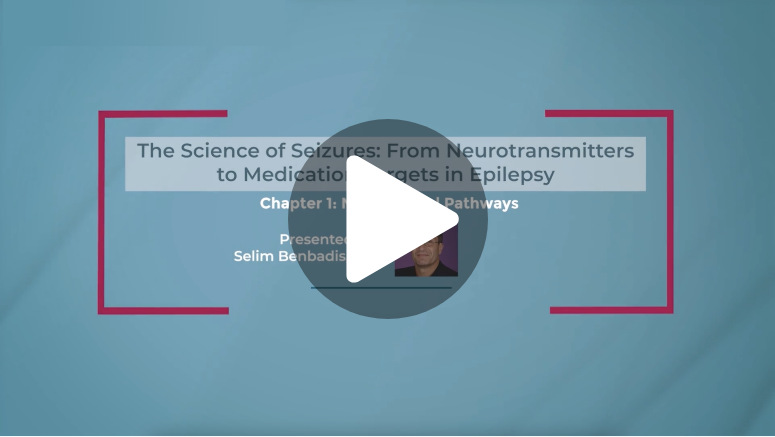[Music]
KING-STEPHENS:
Hi, I’m Dr David King-Stephens.
Welcome to chapter 3. In this chapter, we will present an overview of the pharmacologic and clinical profile of perampanel.
Perampanel is an antiseizure medication (or ASM) that antagonizes the AMPA receptor. Perampanel may work to reduce glutamate activity at the postsynaptic site and prevent the synchronized firing that drives seizure propagation.
Here, we’ll review data from a partial-onset seizure clinical trial of perampanel as first adjunctive therapy after ASM monotherapy failure.
Perampanel is indicated in patients with epilepsy aged 4 years and older for partial-onset seizures with or without secondary generalized seizures.
Perampanel is also indicated as adjunctive therapy for patients aged 12 years and older for primary generalized tonic-clonic (or PGTC) seizures.
Please see the Important Safety Information throughout this video, including the Boxed WARNING, and the full Prescribing Information.
We believe there are 5 main reasons why clinicians should consider perampanel as first adjunctive therapy in patients with partial-onset seizures.
Perampanel is a broad-spectrum agent that offers potential control across a broad spectrum of seizure types.
As a selective noncompetitive AMPA receptor antagonist, it has a novel mechanism of action.
It has a long half-life of up to 105 hours.
The pill is small and is taken once a day.
And perampanel has a well-established efficacy and safety profile.
As we mentioned earlier, perampanel has a unique mechanism of action and is the first and only noncompetitive AMPA receptor antagonist.
Glutamate is the primary neurotransmitter regulating excitatory synaptic transmission in the brain, and perampanel is the only ASM with AMPA receptor activity as its therapeutic target.
Note that the precise mechanism by which perampanel exerts its antiseizure effects in humans is unknown.
Perampanel is specifically engineered to block glutamate activity at postsynaptic AMPA receptors. It potentially targets hyperexcitatory neurotransmission by inhibiting AMPA glutamate receptor activity.
Now, we’re going to summarize the 3 pivotal trials for perampanel in partial-onset seizures with or without secondarily generalized seizures.
Patient dosages were titrated every week over a 6-week titration period at doses of 2 mg, 4 mg, 6 mg, 8 mg, and 12 mg.
The primary endpoint was median percent reduction in partial-onset seizure frequency per 28 days, and this endpoint was met.
Perampanel achieved proven reductions in partial-onset seizure frequency at doses of 4, 8, and 12 mg/day, with inducer and non-inducer ASMs.
The secondary endpoint of 50% or greater reduction in partial-onset seizure frequency was also met.
Up to 54% of patients experienced a 50% or greater reduction in partial-onset seizure frequency with perampanel.
The prespecified exploratory endpoint of median percent reduction in secondarily generalized seizure frequency per 28 days was met, as well.
Up to a 75% frequency reduction in secondarily generalized seizures was achieved with perampanel.
The post hoc exploratory endpoint of seizure freedom in secondarily generalized seizures also was met.
Up to 36% of patients with secondarily generalized seizures were convulsive seizure-free during the 13-week maintenance phase.
The most common adverse reactions were dizziness and disturbance in gait or coordination (including ataxia, gait disturbance, balance disorder, and abnormal coordination); somnolence; and fatigue-related events (including fatigue, asthenia, and lethargy).
Discontinuation due to adverse reactions occurred in 5% of participants taking placebo, 3% of patients taking perampanel 4 mg, 8% of patients taking perampanel 8 mg, and 19% of patients taking perampanel 12 mg.
For more information on the perampanel pivotal trials, please see section 14.1 of the Full Prescribing Information.
DR BENBADIS:
Hi, I’m Dr Selim Benbadis.
Perampanel is dosed once daily at bedtime and has a notably long half-life of up to 105 hours based on a model of 4-mg daily treatment over a period of 4 weeks.
The long half-life of perampanel was established in phase I clinical trials with healthy adults. In pediatric patients ages 4 to 11, the half-life of perampanel is long but is reduced by approximately half.
In the presence of concomitant moderate or strong CYP3A4 inducers, perampanel continues to have a long half-life, but it is reduced by approximately half in both adults and pediatrics.
Due to its long half-life, perampanel has a relatively low peak-to-trough fluctuation, which indicates that drug concentrations will remain relatively stable throughout the dosing interval.
The time to maximum serum concentration of perampanel ranges between 0.5 and 2.5 hours under fasted conditions. Steady-state is achieved in about 2 to 3 weeks.
Clinicians should allow sufficient time to evaluate the effect of any perampanel dose changes.
The simulated concentration time profile shown here was based on 8-mg, once-daily dosing in adults.
This graph demonstrates modeled perampanel plasma exposure in a patient who has missed a dose at day 15 and resumed their regular dosing the following day, with and without enzyme-inducing ASM carbamazepine.
Without carbamazepine, on day 15, the trough concentration declined by 18%, and the peak concentration declined by 12%. Within 6 to 7 days of the missed dose, modeled perampanel exposure was very close to that of a patient who did not miss a dose.
With carbamazepine, on day 15, the trough concentration declined by 44%, and the peak concentration declined by 15%. Within 3 to 4 days of the missed dose, modeled perampanel exposure was very close to that of a patient who did not miss a dose.
Remember that, per the prescribing information, perampanel should be administered once daily at bedtime.
Patients who miss a dose should resume dosing the following day at their prescribed dose. Instruct patients to contact their healthcare provider if more than 1 day of dosing is missed.
Perampanel is administered as a tablet or an oral suspension (0.5 mg/mL) and as a single dose, once daily, to be taken at bedtime, defined as “when head hits the pillow.”
Perampanel is dosed in children the same as it is in adolescents and adults. No weight-based dosing is required.
Let’s review the dosing of perampanel in the absence of moderate or strong CYP3A4 Inducers.
Patients are initiated on perampanel at a dose of 2 mg tablets once daily. Titration of perampanel should be undertaken in 2 mg increments no more frequently than at weekly intervals. The dose is increased until the maximum tolerable dose or maximum dose of 12 mg once daily.
Patients on perampanel will continue to be monitored for clinical response and tolerability.
The recommended maintenance dose range for patients with partial-onset seizures is 8 mg to 12 mg once daily; however, efficacy was seen as early as 4 mg in the partial-onset seizures pivotal trials.
The recommended maintenance dose for patients with PGTC seizures is 8 mg once daily at bedtime.
Dosage adjustment and close monitoring is recommended for patients when starting or withdrawing moderate or strong CYP3A4 inducers (including enzyme-inducing ASMs, such as carbamazepine, phenytoin, and oxcarbazepine).
Use of perampanel with moderate and strong CYP3A4 inducers, including enzyme-inducing ASMs, such as phenytoin, carbamazepine, and oxcarbazepine, causes a reduction in perampanel plasma levels.
Patients with partial-onset seizures or PGTC seizures who are taking moderate or strong CYP3A4 inducers should start at 4 mg daily; there is no established maintenance dose; titration should be based on clinical response and tolerability; the highest dose studied in patients with concomitant enzyme-inducing ASMs was 12 mg once daily.
Patients who miss a dose of perampanel should be advised to continue with their daily dosing as normal without trying to make up for the missed dose. Instruct patients to contact their healthcare provider if more than 1 day of dosing is missed.
Perampanel has a Boxed WARNING for serious psychiatric and behavioral reactions.
Serious or life-threatening psychiatric and behavioral adverse reactions, including aggression, hostility, irritability, anger, homicidal ideation, and threats, have been reported in patients taking perampanel.
These reactions occurred in patients with and without a prior psychiatric history, prior aggressive behavior, or concomitant use of medications associated with hostility and aggression.
Monitor patients for these reactions as well as for changes in mood, behavior, or personality that are not typical for the patient, particularly during the titration period and at higher dose.
Perampanel should be reduced if these symptoms occur and should be discontinued immediately if symptoms are severe or are worsening.
Homicidal ideation and/or threats were seen in 6 out of 4368 perampanel-treated patients in epilepsy and non-epilepsy trials during both the double-blind and open-label trials. This slide shows the information for these 6 cases as described by Ettinger et al and published in Epilepsia in 2015.
Patient ages ranged from 13 to 57 years old, with 3 male and 3 female patients.
Two of the 6 patients had a history of aggression/aggressive behavior, and another 3 patients had previously reported psychiatric history.
Event onset for 4 of these patients occurred during the OLEx phase of the clinical trials. For 2 patients, event onset was during the double-blind phase of the clinical trials.
Two of the patients did not have changes to their dose, 2 of the patients had their dose reduced, and 2 of the patients had the drug withdrawn.
All events occurred while each patient’s dose of perampanel was between 6 and 12 mg.
The verbatim term for the event was “homicidal ideation” in 2 of the 6 patients; for the other patients, the event was included because of additional information provided by the investigator in the narrative description of the event or in discharge notes that suggested that the patient experienced homicidal ideation.
In all 6 patients, homicidal ideation symptoms were resolved.
Homicidal ideation and/or threat have also been reported in postmarketing in patients treated with perampanel.
[NARRATOR]
The Important Safety Information for perampanel provides additional information around the Boxed Warning.
In the partial-onset seizures clinical trials, hostility- and aggression-related adverse reactions occurred in 12% and 20% of patients randomized to receive perampanel at doses of 8 mg and 12 mg per day, respectively, compared to 6% of patients in the placebo group.
These effects were dose-related and generally appeared within the first 6 weeks of treatment, although new events continued to be observed through more than 37 weeks. These effects led to dose reduction, interruption, and discontinuation.
The combination of alcohol and perampanel significantly worsened mood and increased anger. Patients should avoid the use of alcohol.
Patients, their caregivers, and families should be informed that perampanel may increase the risk of psychiatric events.
Patients should be monitored during treatment with perampanel, especially when taking higher doses.
NARRATOR:
This table lists some of the hostility- and aggression-related events that were observed during the perampanel phase 3 double-blind partial-onset seizure clinical trials (using Medical Dictionary for Regulatory Activities, or MedDRA, preferred terms). Note that the cutoff for this chart was total events occurring in more than 3 patients, so events that occurred in fewer patients than that are not included here.
Pooled data from the phase 3 trials in partial-onset seizures showed elevated rates of treatment-emergent adverse events suggestive of hostility and aggression in patients receiving perampanel compared to those receiving placebo at rates of 12% and 20% for 8 mg and 12 mg of perampanel. The most common of these were irritability (6.7% and 11.8% for 8 mg and 12 mg with perampanel vs 2.9% with placebo) and aggression (1.6% and 3.1% for 8 mg and 12 mg with perampanel vs 0.5% with placebo).
During the phase 3 double-blind partial-onset seizure trials, 0.7% of patients receiving placebo and 1.6% of patients receiving perampanel discontinued due to hostility- and aggression-related adverse reaction.
Note that the 2 mg/day data are not shown in a separate column, given that it is a titration dose. However, the 2 mg/day data are accounted for in both the total patient numbers and the percentages shown in the total column on the far right.
Antiepileptic drugs, including perampanel, increase the risk of suicidal thoughts or behavior in patients.
Patients, their caregivers, and families should be informed of the risk and advised to monitor and immediately report the emergence or worsening of depression, suicidal thoughts or behavior, thoughts about self-harm, and/or any unusual changes in mood or behavior.
Perampanel caused dose-related increases in events related to dizziness and disturbance in gait or coordination, especially during the titration phase.
Perampanel caused dose-dependent increases in somnolence and fatigue-related events, especially during the titration phase.
Patients should be advised against engaging in hazardous activities requiring mental alertness, such as operating motor vehicles or dangerous machinery, until the effect of perampanel is known.
Patients should be carefully observed for signs of central nervous system (CNS) depression when perampanel is used with other drugs with sedative properties because of potential additive effects.
This table shows the Medical Dictionary for Regulatory Activities, or MedDRA, preferred terms that fall into the category of dizziness-related, fatigue-related and gait disturbance-related events and for which events were reported for perampanel.
There is no cutoff for this chart; all reported events are shown.
Falls were more common in patients taking perampanel at doses of 8 mg and 12 mg versus placebo.
Drug reaction with eosinophilia and systemic symptoms, or DRESS, also known as multiorgan hypersensitivity, has been reported in patients taking AEDs, including perampanel. DRESS may be fatal or life-threatening.
Evaluate your patients if these signs or symptoms are present.
A gradual withdrawal is generally recommended with AEDs to minimize the potential of increased seizure frequency.
Caution should be exercised when perampanel is administered to pregnant or nursing women.
Use in patients with severe hepatic or severe renal impairment is not recommended.
Dosage adjustments are recommended in patients with mild or moderate hepatic impairment.
Use with caution in patients with moderate renal impairment.
Perampanel is a Schedule III controlled substance and has the potential to be abused and lead to drug dependence and withdrawal symptoms.
KING-STEPHENS:
Thanks for tuning in. If you haven’t already watched Chapter 1 of this video series, please do so to learn about the neurological pathways that are disrupted in epilepsy.
To learn about seizure etiologies and their proposed biophysical mechanisms, please watch Chapter 2 in this video series.
And for more information about FYCOMPA (perampanel), please visit FYCOMPAonDEMAND.com




